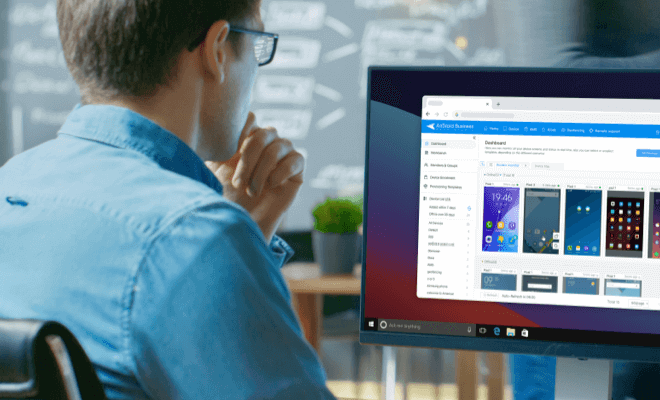BYOD & MDM: How Do They Balance Flexibility and Security?
The corporate landscape has changed. Nowadays, people do pretty much everything from their mobile devices, including for their everyday work tasks, where accessing company data is integral.
This new era of working, known as ‘Bring your own device’ (BYOD), has necessitated organisations to adapt their approach to balancing employee flexibility and data security.
There is a greater need to fortify themselves against security risks while meeting the expectations of their employees and even increasing operational efficiency. Mobile device management (MDM) tools are typically the most effective way to do that, but not all organisations are taking advantage.
For instance, did you know that 61% of companies require their staff to be available remotely, but don’t provide corporate phones to meet that need?

That means employees are using unprotected personal devices and exposing organisations to significant threats unnecessarily. This is where an MDM BYOD solution could tackle that challenge.
Part 1: What is BYOD?
In this technological era, mobile phones are ubiquitous. In fact, around 86% of the world’s population owns a smartphone, which is a staggering number to think about. That’s one of the major reasons that BYOD policies are becoming the standard approach to a hybrid working policy within organisations across all industries.
When implemented effectively, BYOD provides flexibility and boosts morale by enabling staff to work anywhere, while empowering organisations to cut costs and achieve scalability.

This mobile revolution began over a decade ago with the explosion of smartphones, with BYOD and hybrid working becoming a mainstay in a post-COVID-19 world, where swathes of the working population now with the expectation of remote or hybrid policies. Therefore, it’s crucial that organisations adapt to that change quickly.
Before we jump into that, let’s look at BYOD in a bit more detail.
Part 2: What are the pros and cons of BYOD?
BYOD policies can be a fantastic approach for organisations to take, but it’s important to understand the advantages and disadvantages they can present, particularly when implemented in isolation from any other measures.
Advantages
• Cost Savings: By not having to continuously accommodate significant budget for new hardware or software, organizations can find themselves making big operational cost savings
• Increased productivity: Employees can access work documents from any device, boosting productivity
• Employee satisfaction: That accessibility and freedom can bring about a significant increase to employee satisfaction
• Flexibility and convenience: Accessibility and mobility equal flexibility and convenience, an advantage that’s hard to overlook from an employee perspective
Disadvantages
• Security concerns: If improperly managed, BYOD policies can present a significant security risk to organisations as IT admins don’t have oversight of the device fleet in a manageable way
• Support complexity: A fleet of devices with myriad operating systems, troubleshooting approaches, and ways of working is likely to cause significant unnecessary strain on IT admins
• Compatibility issues: Multiple devices and OS’s can then result in compatibility issues – some devices may not be able to support key operational tasks
• Legal and compliance risks: Without clear and effective policies in place to manage employee-owned devices, organizations expose themselves to potential legal and compliance issues
For example, if an employer ever needs to access company data on an employee's device for a legitimate reason, would they have the capability to do so without appropriate measures in place?

Part 3: What’s the purpose of MDM?
MDM is a foundational solution for businesses, providing a balanced approach to device usage by employees, where flexibility and data security is closely managed.
With an effective solution, organisations can safeguard company data through the comprehensive management, deployment and monitoring of their fleet of devices, whether employee-owned or otherwise.
Features involved in an MDM solution are far ranging, but some of those controls might be:
• Device enrolment: Register and configure a new device. For instance, deploy security policies, download apps required for work, register the device with the network or system
• Device tracking: Monitoring device locations and status in real-time
• Remote provisioning and troubleshooting Identifying and resolving issues with devices remotely or configuring them with the necessary settings
• Locking down devices: Preventing misuse of apps, settings, and websites by locking down aspects of the device.
As you can see, an MDM solution is quite an ideal complement if you have a BYOD policy in place.
Part 4: What makes BYOD and MDM a great pair?
Without an MDM BYOD solution, BYOD policies are practically unrestrained and the challenges they pose remain unchecked without one.
For organisations who want to maximise the productivity of employees and simultaneously safeguard themselves from numerous threats, an MDM solution can enable that in several significant ways:
1Centralised management
Centrally manage all devices in an easy and secure way, irrespective of device type or operating system. This empowers your IT admins to have centralised management of devices when using MDM
2Data security and compliance
Enforce security policies at scale and provision devices with profiles that keeps data segmented from personal information, as well as the power to encrypt work-related data with VPNs solely for work apps.
You can also enforce biometric authentication and remote wipe to add further protections and prevent intentional or unintentional data leaks or misuse of organisational resources
3Simplified deployment and updates
An effective MDM tool can enable IT admins to seamlessly deploy business-relevant apps and make updates. This can include scheduled released updates, progress monitoring, forced installation on unattended devices, and more.

Datasheet for Mobile Device Management
If you want deeper insights into why MDM can establish data security and employee flexibility in a BYOD environment, take a look at our free datasheet. It’s loaded with detailed information to help you make the best decision for your organization's needs.
Part 5: BYOD MDM best practices
To really get the most out of bringing together a clear, robust BYOD MDM solution, there are some best practices you can follow.
Develop comprehensive policies
Strong, clear and agile policies enable all stakeholders to be on the same page at all times.
For example, providing transparent guidelines and FAQs on whether the MDM tracks browser history, what happens if an employee leaves the organisation, or which employees are eligible for BYOD, where relevant.
These policies should also outline acceptable usage, security measures, and consequences for policy violations.
Enforce strong security measures
By having strong security measures, such as remote wipe, device encryption, and biometric authentication, you’re buttressing against unauthorized access, lost or stolen devices, and data breaches.
Regular employee training
Employees should always be kept up-to-date with the latest security training while being regularly guided on best practices.
The more aware they are, the more compliance and model behaviour you’ll see as a result.
Balancing user experience with security
BYOD and MDM is a fine balancing act. One way of securing company data while giving employees flexibility is through techniques like containerization, a type of software ‘packaging’ that stores software into separate virtual ‘containers’.
Essentially, the device programs, apps, files and others are stored separately to the employee’s personal data, making it easier and seamless for IT admins to manage, deploy, and secure applications to create a more secure environment and better user experience for employees. One such example is Google's Work Profile.
Part 6: Conclusion
Hybrid work and BYOD are now commonplace trends in modern workplaces. As a result, organizations must directly address the challenge of striking a balance between their operational needs and the user experience of their employees. Mobile Device Management (MDM) emerges as a vital solution, seamlessly improving efficiency, enhancing security, and offering strong support.
Nonetheless, in this ever-changing digital environment, ongoing monitoring and improvement are essential. These continual efforts bring widespread benefits to the organization, guaranteeing its success in adapting to this new work landscape.




Leave a Reply.